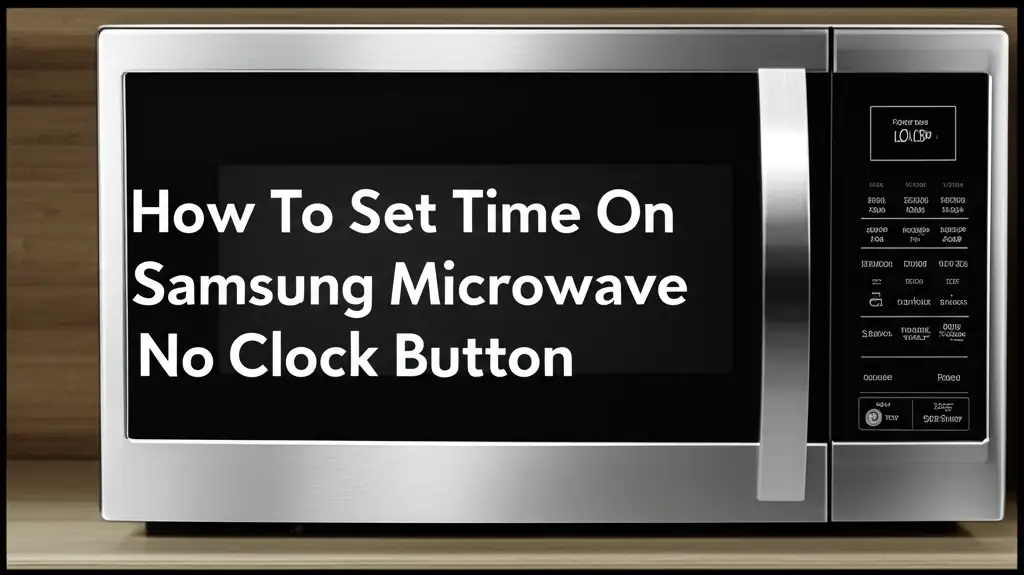· Todd Martin · Home Appliances · 19 min read
How To Set Time On Samsung Microwave No Clock Button

Set Your Samsung Microwave’s Time (No Clock Button Needed)
Have you ever looked at your Samsung microwave, wanting to set the time, but saw no “Clock” button? It can be a little puzzling at first. Many modern Samsung microwave models integrate the clock setting function into other buttons. I understand this confusion because I’ve been there myself. Getting the correct time displayed on your microwave is useful. It helps with cooking, especially if you rely on its timer. This article will guide you through the exact steps. We will cover various Samsung models. You will learn how to set the time on your Samsung microwave, even without a dedicated clock button. We will also explore common issues and offer practical solutions. You will gain a clear understanding of your appliance.
Takeaway
- Identify the Correct Button: Look for “Clock,” “Time,” “Set Clock,” or a number pad button.
- Enter Time Mode: Press the identified button once or twice.
- Input Time: Use the number pad to enter the current time.
- Confirm Setting: Press the “Start” or “Clock” button again to save.
- Troubleshoot: Check power, reset the microwave, or consult the user manual if issues arise.
How to set the time on a Samsung microwave without a dedicated “Clock” button?
Most Samsung microwaves allow time setting by pressing a “Clock” or “Time” button that might also serve another function, or by pressing a number pad button like “0” for a few seconds. After activating time-setting mode, input the current time using the number pad, then confirm by pressing “Start” or “Clock” again.
Understanding Samsung Microwave Controls (No Dedicated Clock Button)
It is common for new appliances to simplify their control panels. Samsung microwaves often do this. You might not see a separate button labeled “Clock” on many Samsung models. This design choice aims to make the interface cleaner. It also gives buttons multiple functions. For example, a button might be “Kitchen Timer” and “Clock” simultaneously. Or, the time setting could be hidden under a general “Settings” or “Options” menu.
This integrated approach helps reduce clutter. It gives your microwave a sleek look. However, it can make setting the time less intuitive for first-time users. You might expect a direct button. Instead, you need to know the specific sequence of presses. The exact method often depends on your specific Samsung model. It can vary between different series. For instance, an over-the-range model might differ from a countertop unit. My own experience has shown me that looking closely at the control panel is key. Sometimes, the “Clock” function is printed below another button’s primary label.
Do not worry if you cannot find a distinct “Clock” button. You are not alone. Many users face this initial confusion. The absence of this button does not mean you cannot set the time. It simply means the function is accessed differently. We will explain how to find this hidden function. Knowing this makes setting the time simple. We will cover the most common methods used by Samsung. This will help you get your microwave display showing the correct time.
Step-by-Step Guide: Setting the Time with the “Clock” or “Time” Pad
Setting the time on your Samsung microwave without a clear “Clock” button is usually straightforward. Many Samsung models combine the clock function with another button. I have found this to be the most frequent method. Look closely at your microwave’s control panel. You are looking for a button that might say “Clock/Kitchen Timer,” “Time,” or even just “Set Clock.” Sometimes, the word “Clock” is printed directly beneath or above another button’s main label.
Once you have identified the correct button, follow these steps:
- Locate the “Clock” or “Time” Button: Find the button. It might also have “Kitchen Timer” or “Set Clock” printed on it. This button is your gateway to the time setting function.
- Press the Button Once or Twice:
- For most models, pressing this button once will activate the clock setting mode.
- Some models might require you to press it twice. This action often clears the current time or makes the display blink. The blinking display indicates it is ready for input.
- Enter the Current Time: Use the number pad to input the current time. For example, if it is 3:30 PM, you would press “3,” “3,” “0.” If your microwave uses a 12-hour format, it will often automatically adjust or require you to press “AM/PM” later. If it is 9:15 AM, you would press “9,” “1,” “5.” Make sure to enter all four digits, even for times before 10:00 AM (e.g., 08:00 for 8 AM).
- Confirm the Time Setting: After entering the time, you need to save it. Press the “Clock” or “Time” button again. On some models, you might need to press the “Start” button instead. This final press locks in the new time. The display should stop blinking and show the time you entered.
If these steps do not work, do not worry. Samsung has many models. Some might have slightly different procedures. We will explore other methods next. Knowing these common steps covers most situations.
Alternative Methods: Using Number Pads or Preset Functions
Not all Samsung microwaves follow the “Clock/Time” button convention directly. Some models offer alternative ways to set the time. I have encountered microwaves where the clock function is less obvious. It might be integrated into a different kind of control. One common alternative involves using the number pad. Some models allow you to press and hold a specific number button.
Here are a few alternative methods you might find on your Samsung microwave:
- Press and Hold a Number Pad Button: On certain Samsung models, especially older ones or specific compact designs, you might set the clock by pressing and holding the “0” or “1” button for a few seconds. This action could initiate the clock setting mode. If it does, the display will usually start blinking. Then, you would proceed to enter the time using the number pad and confirm it. This method simplifies the control panel further. It makes a single button serve multiple purposes.
- Using a “Settings” or “Options” Button: Some advanced Samsung microwaves have a “Settings,” “Options,” or “Menu” button. This button typically leads to a submenu. Within this menu, you might find a “Clock” or “Time Set” option. You would use the number pad or directional arrows to navigate through the menu choices. Once “Clock” is selected, the process for entering the time usually mirrors the standard method: input digits and confirm. This approach is more common on higher-end models with digital displays.
- “Auto Cook” or “Quick Start” Button Integration: In very rare cases, the clock setting function might be subtly linked to an “Auto Cook” or “Quick Start” button. This is less common for the initial time setting. However, it can sometimes be part of a reset sequence. Always check your microwave’s specific user manual if the common methods do not apply. I always recommend keeping the manual handy.
- Power Cycle Reset: Sometimes, a simple power cycle can activate a “set time” prompt. If your microwave completely loses power, it often prompts you to set the time when power is restored. You might unplug the microwave for 30 seconds. Then plug it back in. This might reset the display. It might then ask you to set the clock. This is a common troubleshooting step for many appliances. If your Samsung microwave is not working but has power, a reset can sometimes fix minor glitches. For more complex issues like heating problems, you might need to investigate why your Samsung microwave turns on but not heat.
Always remember that the user manual for your specific Samsung microwave model is your best friend. It provides the exact instructions for your appliance. You can usually find digital copies online if you do not have the physical manual. Just search for your microwave’s model number.
Troubleshooting Common Issues When Setting Time
Setting the time on your Samsung microwave usually goes smoothly. Sometimes, you might encounter unexpected issues. I have certainly faced my share of appliance quirks. Knowing how to troubleshoot these problems saves time and frustration. If your microwave is not responding as expected, consider these common scenarios and solutions.
Display Not Responding or Not Blinking:
- Check Power: First, ensure the microwave has power. The display should be lit. If it is completely blank, check the power outlet. Ensure the cord is fully plugged in. Try plugging another small appliance into the same outlet to confirm it has power. If your microwave is not working but has power, the issue might be internal.
- Power Cycle the Microwave: Unplug the microwave from the wall outlet. Wait for about 30 seconds to a minute. Then, plug it back in. This action can reset the internal electronics. It often resolves minor glitches. Sometimes, this brings up the “Set Clock” prompt automatically.
- Confirm Button Press: Ensure you are pressing the button firmly enough. Some touchpads require a distinct press. Make sure your fingers are clean and dry.
Time Not Saving or Reverting to 12:00:
- Incorrect Confirmation: The most common reason for this is not confirming the time correctly. After entering the digits, you must press the “Clock” or “Start” button one final time. If you miss this step, the microwave will not save the new time. It will often revert to its default state.
- Power Interruption: If your microwave loses power even for a second, it will reset the clock. This can happen during a brief power flicker. If this is a recurring issue, consider connecting your microwave to a surge protector.
- Internal Battery (Rare): Very few microwave models have a small internal battery to maintain the clock during brief power outages. If this battery is failing (which is very rare in microwaves), it might not hold the time. This is usually a sign of a much larger internal problem requiring professional service.
Specific Model Quirks:
- Child Lock/Control Lock: Some Samsung microwaves have a child lock feature. This feature disables the control panel. If active, you cannot press any buttons. Look for an indicator light or symbol. Usually, you press and hold a “Lock” or “Cancel” button for a few seconds to toggle this feature.
- Hidden “Clock” Button: As mentioned, sometimes the “Clock” function is an unlabeled part of another button’s action. Consult your user manual. It will show the exact procedure for your model.
- Error Codes: If your display shows an error code, this indicates a specific problem. Refer to your manual for the meaning of the code. For example, if your Samsung microwave says filter on the screen, it is a specific maintenance alert. Other error codes might indicate internal malfunctions.
By systematically going through these troubleshooting steps, you can often resolve most time-setting issues. If the problem persists, consulting the official Samsung support website or contacting their customer service is the next best step.
Why Your Microwave Needs the Correct Time: Beyond Convenience
Having the correct time displayed on your Samsung microwave might seem like a small detail. However, its importance extends beyond simple convenience. I have found that a properly set clock contributes to several aspects of kitchen life. It is not just about knowing the current hour. It affects various functions.
- Enhanced Kitchen Synchronization: The microwave clock often serves as the primary timekeeper in many kitchens. It provides a quick, at-a-glance reference. This helps you coordinate cooking times. It also helps manage meal preparation. A synchronized clock contributes to a more efficient kitchen. You avoid needing to check your phone or a different clock.
- Timer and Delayed Start Accuracy: Many Samsung microwaves offer features like a kitchen timer or a delayed start function. These rely on the internal clock. If the clock is incorrect, your kitchen timer will be off. A delayed start might begin at the wrong time. This could ruin a perfectly planned meal. Imagine setting a casserole to start cooking in an hour, but the microwave’s clock is 30 minutes behind.
- Consistent Operation: While not directly tied to the heating process, an accurate clock signifies that your microwave’s internal systems are functioning correctly. It is a small indicator of overall operational health. If your microwave’s clock resets frequently, it might point to unstable power connections. It could also point to a developing internal issue. This is less critical than problems where your microwave turns on but not heat, but it is still a sign.
- Energy Efficiency (Minimal Impact): For the clock display itself, the energy consumption is very low. However, some newer “smart” microwaves might use the clock as part of their energy management system. This is a very minor point, but it shows the clock’s role in the appliance’s total design.
- Maintaining Appliance Value: Keeping all functions of your appliance working correctly, including the clock, helps maintain its overall value. If you ever decide to sell or upgrade, a fully functional appliance is more appealing. It indicates good care. A well-maintained appliance performs better over its lifespan.
Think of the clock as a fundamental component of your microwave’s control system. It forms the basis for all time-dependent operations. Setting it correctly ensures you get the most out of your appliance’s features. It helps keep your kitchen running smoothly. For instance, setting the time on your Frigidaire microwave with no clock button or knowing how to set time on GE microwave with no clock button are similar small steps that improve daily appliance use.
Maintaining Your Samsung Microwave for Optimal Performance
Setting the time is just one aspect of owning a Samsung microwave. Regular maintenance ensures it performs well for years. I believe in taking good care of all my appliances. A clean and well-maintained microwave operates efficiently. It also prolongs its lifespan. Proper care helps prevent many common issues.
Here are key maintenance tips for your Samsung microwave:
- Regular Cleaning: Food splatters and spills are inevitable. They can accumulate inside the microwave. These residues can cause odors. They can also attract pests. More importantly, food particles can absorb microwave energy. This reduces heating efficiency.
- Interior Cleaning: Wipe the interior regularly with a damp cloth and mild detergent. For stubborn stains, I often use a bowl of water with lemon slices or vinegar. Heat it for a few minutes. The steam loosens the grime. Then, wipe it clean. Learning how to clean microwave stains or how to clean microwave with vinegar are excellent skills to master.
- Exterior Cleaning: Wipe down the exterior, control panel, and door with a soft, damp cloth. Avoid harsh abrasives or spray cleaners directly on the control panel. These can damage the display or buttons.
- Check and Clean Filters (If Applicable): Many over-the-range Samsung microwaves have a charcoal filter and a grease filter.
- Grease Filters: These are usually located underneath the microwave. They trap grease from your cooktop. Remove and wash them regularly (often monthly) with hot, soapy water. Some are dishwasher safe.
- Charcoal Filters: These remove odors from the air. They are typically located behind the vent grille at the top front of the microwave. These cannot be washed. They need replacement every 6-12 months, depending on usage. If your Samsung microwave says filter on the screen, it is likely prompting you to check or replace these.
- Inspect the Door Seal: The door seal is crucial for safe and efficient operation. It contains the microwave energy. Inspect it regularly for any signs of wear, tears, or damage. A damaged seal can lead to energy leakage. This makes the microwave less efficient. It can also pose a safety risk. If the door itself seems misaligned or your Samsung microwave turns on when I open the door, it needs professional attention.
- Turntable Care: The glass turntable and its support ring should be kept clean. Food debris under the turntable can prevent it from rotating smoothly. This leads to uneven heating. Wash the turntable and the ring assembly in warm, soapy water.
- Proper Ventilation: Ensure the microwave’s vents are not blocked. Proper airflow prevents overheating. Over-the-range models need clear ventilation from the cooktop below. Built-in models require specific clearances. Refer to your manual for ventilation requirements.
- Avoid Overloading: Do not place excessively heavy items on the turntable. This can strain the motor. Also, avoid placing metal objects inside the microwave. Metal can cause arcing and damage the appliance.
- Professional Servicing: If you notice unusual noises, sparks, or if the microwave heats poorly (e.g., your Samsung microwave turns on but not heat), seek professional help. Do not attempt internal repairs yourself. Microwave components store high voltage even when unplugged.
- Regular Power Cycling: Occasionally unplugging your microwave for a minute or two can help clear minor electronic glitches. This is similar to restarting a computer. It can sometimes resolve issues like the clock not setting or other minor control panel problems. If your Samsung microwave is not working but has power, this simple step can sometimes revive it.
By following these maintenance practices, you will keep your Samsung microwave in top condition. It will serve you reliably for many years.
Understanding Different Samsung Microwave Models
Samsung manufactures a wide range of microwave ovens. Each model series often features unique characteristics. This can include control panel layouts. This diversity explains why the method to set the time can vary slightly. I have observed these differences in my own research and use. Understanding these distinctions helps when you are troubleshooting or setting up your specific appliance.
Samsung offers several types of microwaves:
- Countertop Microwaves: These are popular for their portability and ease of use. They come in various sizes. Their control panels are usually simpler. They might have membrane touchpads or a mix of buttons and a dial. Many of these models are likely to use the “Clock/Timer” combined button method for setting time. Their compact design often means fewer dedicated buttons.
- Over-the-Range (OTR) Microwaves: These models are installed above a cooking range. They often integrate ventilation features. Their control panels can be more complex due to added functions like fan speed and light controls. The “Clock” button on OTR models might be prominent. However, on sleeker designs, it could be combined or accessed through a menu. These models frequently have digital displays that show time.
- Built-In Microwaves: Designed to fit seamlessly into kitchen cabinetry. These often have a more premium look. Their control panels are typically sophisticated, sometimes featuring LCD screens or touch-sensitive surfaces. With these models, the clock setting could be found within a “Settings” or “Menu” option on the digital display. You might navigate using directional arrows or touch icons.
- Microwave Combos (e.g., Speed Ovens): Some Samsung models combine microwave functionality with convection oven capabilities. These are often called speed ovens. Their interfaces are usually highly advanced. They feature large displays and extensive menu systems. The clock setting on these units is almost certainly found within a “Settings” or “System” menu. You would select it using on-screen prompts. For example, setting the clock on a Whirlpool Smart Oven Microwave Combo often involves navigating through a digital interface.
Despite these differences, a common thread runs through Samsung’s design philosophy. They aim for user-friendly controls. If a dedicated “Clock” button is absent, the function is usually integrated into another logical control. Always refer to your microwave’s specific model number. This number is typically found on a label inside the microwave door frame. Once you have the model number, you can download the precise user manual from Samsung’s official support website. This manual will provide the exact instructions for setting the time on your particular unit. Understanding your specific model helps you understand its controls. This knowledge simplifies all operations, not just setting the clock. It also helps in troubleshooting any issues you might encounter.
FAQ Section
Q1: Why does my Samsung microwave not have a clock button?
Samsung designs its microwaves with simplified control panels. To achieve a cleaner look, they integrate the clock function into other buttons. You will often find “Clock” combined with “Kitchen Timer” or another multi-function button. This approach streamlines the interface. It allows buttons to serve more than one purpose. It is a modern design choice for many appliances.
Q2: What if my Samsung microwave has a ‘Kitchen Timer’ button instead?
If your Samsung microwave has a ‘Kitchen Timer’ button but no ‘Clock’ button, this button likely serves both purposes. Press the ‘Kitchen Timer’ button once or twice. This action should activate the clock setting mode. The display will usually start blinking. Then, you can enter the time using the number pad and confirm it.
Q3: How do I reset the time after a power outage?
After a power outage, your Samsung microwave’s clock will likely reset to 12:00 or go blank. To reset it, simply follow the standard procedure for setting the time. Press the “Clock” or “Time” button (or the combined button like “Kitchen Timer”), enter the current time using the number pad, and then press the “Clock” or “Start” button to confirm and save.
Q4: Can I turn off the clock display on my Samsung microwave?
Some Samsung microwave models allow you to turn off the clock display. This feature helps save a tiny bit of energy or reduce light in the kitchen. Check your user manual for specific instructions. Often, you can press and hold the “Clock” or “Cancel/Off” button for a few seconds. This action might toggle the display on or off.
Q5: What if pressing ‘Clock’ or ‘Time’ does nothing?
If pressing the “Clock” or “Time” button does not work, first ensure the microwave has power and is not in a “Control Lock” mode. Unplug the microwave for 30 seconds, then plug it back in. This can reset the system. If it still does not respond, consult your microwave’s user manual for model-specific instructions or potential error codes.
Q6: Do all Samsung microwaves set time the same way?
No, not all Samsung microwaves set time the exact same way. While many use a combined “Clock/Timer” button, variations exist. Some models might use a “Settings” menu accessed via a digital display, while older or very basic models might require holding down a number pad button like “0.” Always refer to your specific model’s user manual for precise instructions.
Conclusion
Setting the time on your Samsung microwave without a visible “Clock” button can seem confusing. However, it is a straightforward process once you know the common methods. Remember to look for a combined “Clock/Kitchen Timer” button or explore the “Settings” menu on more advanced models. My own experience shows that a quick check of the user manual often clarifies any confusion.
Having the correct time displayed does more than just show you the hour. It helps your kitchen timer work accurately. It ensures delayed start functions operate as intended. Maintaining your Samsung microwave, from regular cleaning to checking filters, also ensures its long-term performance. If you ever face issues like your Samsung microwave not working but has power, a quick check of the clock setting can be part of your initial troubleshooting.
Take a moment to correctly set the time on your Samsung microwave. This simple step will enhance your daily kitchen experience. It makes your appliance more functional. If you encounter persistent problems, always consult your specific model’s user manual or Samsung’s official support resources for assistance. Enjoy a well-timed, efficient kitchen!
- samsung microwave
- set time
- no clock button
- microwave clock
- kitchen appliance
- Samsung settings
- appliance maintenance





